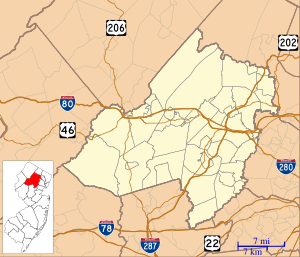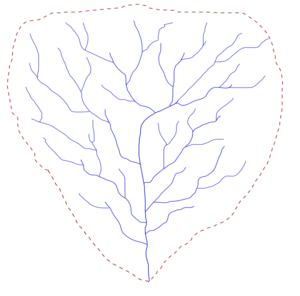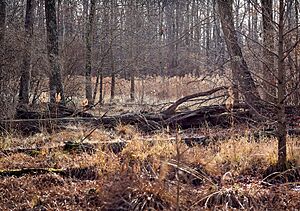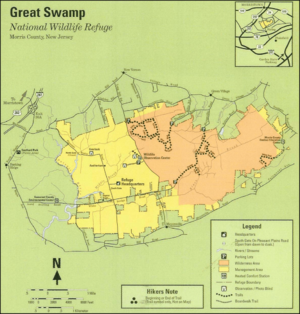Great Swamp National Wildlife Refuge facts for kids
Quick facts for kids Great Swamp National Wildlife Refuge |
|
|---|---|
|
IUCN Category IV (Habitat/Species Management Area)
|
|
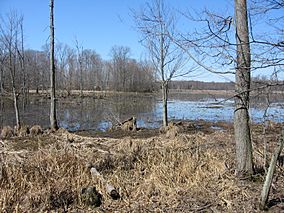
Great Swamp National Wildlife Refuge in New Jersey during March
|
|
| Location | Morris County, New Jersey, United States |
| Nearest city | New Providence, New Jersey |
| Area | 7,800 acres (32 km2) |
| Established | 1960 |
| Governing body | U.S. Fish and Wildlife Service |
| Website | Great Swamp National Wildlife Refuge |
| Designated: | May 1966 |
The Great Swamp National Wildlife Refuge is a special natural area in Morris County, New Jersey. It was created in 1960 to protect wildlife and their homes. This refuge is one of over 550 similar places in the National Wildlife Refuge System across the United States.
In 1966, the Great Swamp was named a National Natural Landmark. This means it's a nationally important natural site. A part of the refuge was also made a "wilderness area" in 1968. This was the first time a wilderness area was created within the Department of the Interior, making it extra special!
Contents
Managing the Refuge
The Great Swamp National Wildlife Refuge is looked after by the United States Fish and Wildlife Service. This is a government agency that helps protect nature. The refuge covers parts of Chatham, Harding, and Long Hill townships.
History of the Great Swamp
How the Swamp Formed
The Great Swamp is what's left of a huge ancient lake called Glacial Lake Passaic. About 15,000 to 11,000 years ago, this lake was enormous. It stretched about 30 miles (48 km) long and 10 miles (16 km) wide!
The lake formed when the Wisconsin Glacier melted at the end of the last Ice Age. The glacier pushed a lot of dirt and rocks, blocking the old path of the Passaic River. This caused the melting ice water to build up and create the giant lake. Eventually, the water found a new way out, but the land remained a swampy area.
Early People and the Land
About ten thousand years ago, Native Americans arrived in this area. They built settlements, hunted, fished, and farmed. Later, in 1614, Dutch settlers claimed the area as New Netherland. They traded with the native people. After that, British settlers came and took control, calling it the Province of New Jersey.
Today, the refuge is about a quarter of the larger Great Swamp watershed. A watershed is an area of land where all the water drains into a single river or lake. This watershed touches ten modern towns, many of which were settled long before the American Revolution.
Saving the Great Swamp
The Great Swamp National Wildlife Refuge was officially created on November 3, 1960. This happened after a big fight that lasted a whole year! Officials wanted to build a huge airport in the swamp. They thought it would help Newark Airport handle more big planes.
But local residents didn't want an airport built in their beloved swamp. They formed a group called the Jersey Jetport Site Association. In 1959, four women from this group were even kicked out of a meeting about building the airport!
Another important group, the North American Wildlife Foundation, also joined the effort. Together, these groups quickly bought land in the heart of the swamp. They donated it to the government to protect it forever as a National Wildlife Refuge.
Stewart Udall, who was a representative from Arizona, strongly supported these residents. He said they made the greatest effort ever by people in America to protect nature. Later, as the Secretary of the Interior, he helped dedicate the swamp as a refuge in 1964. The first donation was 2,600 acres (1,052 ha), which secured its protection. More land was added over time.
What You'll Find in the Swamp
By 2010, the Great Swamp National Wildlife Refuge had grown to almost 7,800 acres (3,156 ha). That's more than 12 square miles (31 km2)! It has many different kinds of habitats, which are natural homes for plants and animals.
The Great Swamp is a very important place for birds. More than 244 different kinds of birds use it! Many birds stop here to rest and eat during their long migrations along the eastern United States. Other birds live in the swamp all year round.
You can also find many other animals here, like deer, fish, foxes, frogs, muskrats, raccoons, snakes, and turtles. There are also many insects and beautiful wildflowers. Some animals that were hunted by early settlers, like bears and beavers, are sometimes seen too.
The refuge also helps the environment in other ways. It drains the region and soaks up floodwater, releasing it slowly. This is very helpful during heavy rains. It also cleans the water by trapping dirt and pollution.
Groups That Help the Swamp
Many non-profit groups work with the refuge to protect the Great Swamp. The Great Swamp Watershed Association, started in 1981, works to protect the entire 55 square mile (142 km2) watershed around the swamp.
Inside the Great Swamp, there's also a special bird rescue center called The Raptor Trust. It was founded in 1977 and mainly helps birds of prey, like eagles, hawks, and owls.
Lord Stirling Park is next to the refuge. It's part of the Somerset County Park System. The park has great hiking trails, boardwalks, and places to watch wildlife. Its office also has exhibits about the swamp and its animals.
Images for kids


